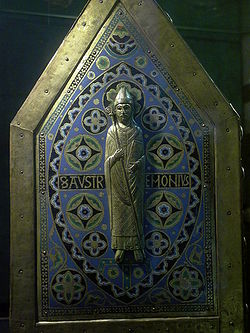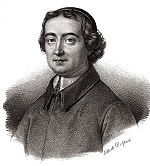- Roman Catholic Archdiocese of Clermont
-
The Roman Catholic Archdiocese of Clermont, is an Archdiocese of the Latin Rite of the Roman Catholic church, in France. The diocese comprises the department of Puy-de-Dôme, in the Region of Auvergne. Its see is Clermont-Ferrand Cathedral. For long a suffragan of the Archdiocese of Bourges, it became a metropolitan see in 2002. The current Archbishop of Clermont is Hippolyte Louis Jean Simon, who was named Bishop of Clermont in 1996 and Archbishop of Clermont when the see was elevated in 2002; he is one of the two current vice presidents of the Conference of Bishops of France.
At first very extensive, in 1317 the diocese lost Haute-Auvergne through the creation of the diocese of Saint-Flour[1], and in 1822 the Bourbonnais, on account of the erection of the diocese of Moulins.
Contents
History
The first Bishop of Clermont was Saint Austremonius (Stramonius). According to local tradition he was one of the seventy-two Disciples of Christ, by birth a Jew, who came with Saint Peter from Palestine to Rome and subsequently became the Apostle of Auvergne, Berry, Nivernais, and Limousin.
At Clermont he is said to have converted the senator Cassius and the pagan priest Victorinus, to have sent Saint Sirenatus (Cerneuf) to Thiers, Saint Marius to Salers, Saint Nectarius (Nectaire) and Saint Antoninus into other parts of Auvergne, and to have been beheaded in 92. This tradition is based on a life of Saint Anstremonius written in the tenth century in the monastery of Mozac, where the body of the saint had rested from 761, and rewritten by the monks of Issoire, who retained the saint's head. Gregory of Tours, born in Auvergne in 544 and well versed in the history of that country, looks upon Austremonius as one of the seven envoys who, about 250, evangelized Gaul; he relates how the body of the saint was first interred at Issoire, being there the object of great veneration.
Clermont counted amongst its bishops a large number of saints, as Saint Urbicus (c. 312); Saint Leoguntius; Saint Illidius (Allyre), who, about 385, cured the daughter of the Emperor Maximus at Trier; the saint's name was given to the petrifying springs of Clermont, and his life was written by Gregory of Tours; Saint Nepotianus (died 388); Saint Artemius (died about 394); Saint Venerandus (Veau, died about 423); Saint Rusticus (424-46); Saint Namatius (446-62), founder of Clermont Cathedral, where he deposited the relics of Saint Vitalis and Saint Agricola brought from Bologna; Sidonius Apollinaris (470-79), the celebrated Christian writer who brought to Clermont the priest Saint Amabilis; Saint Aprunculus (died about 491); Saint Euphrasius (491-515); Saint Quintianus (died about 527), whose life was written by Gregory of Tours; Saint Gallus (527-51), of whom Gregory of Tours was the biographer and nephew; Saint Avitus (second half of the sixth century), founder of Notre-Dame du Port; Saint Caesarius (c. 627); Saint Gallus II (c. 650); Saint Genesius (c. 660); Saint Praejectus (Prix), historian of the martyrs of Clermont and assassinated at Volvic 25 January, 676; Saint Avitus II (676-91); Saint Bonitus, intimate friend of Sigebert II (end of seventh century); Saint Stabilis (823-60). and Saint Sigo (866).
Among the Bishops of Clermont should also be mentioned: Pierre de Cros (1301–04), engaged by Thomas Aquinas to complete his Summa; Étienne d'Albret (1340–42), later Pope Innocent VI (1352–62); Guillaume du Prat (1528–60), founder of the Clermont College at Paris and delegate of Francis I of France to the Council of Trent; and Massillon, the illustrious orator (1717–42). The Diocese of Clermont can likewise claim a number of monks whom the Church honours as saints, viz: St. Calevisus (Calais, 460-541), a pupil in the monastery of Menat near Riom, whence he retired to Maine, where he founded the Abbey of Anisole; St. Maztius (died 527), founder at Royat near Clermont of a monastery which became later a Benedictine priory; St. Portianus (sixth century), founder of a monastery to which the city of Saint-Pourçain (Allier) owes its origin; St. Étienne de Muret (1046–1124), son of the Viscount of Thiers and founder of the Order of Grandmont in Limousin, and St. Peter the Venerable (1092–1156), of the Montboissier family of Auvergue, noted as a writer and Abbot of Cluny.
Several famous Jansenists were natives of Clermont: Blaise Pascal, author of the Pensées (1623–62); the Arnauld family, and Soanen (1647–1740), Bishop of Senez, famous for his stubborn opposition to the Bull "Unigenitus". On the other hand the city of Riom was the birthplace of Sirmond, the learned Jesuit (1559–1651), confessor to Louis XIII and editor of the ancient councils of Gaul. Other natives worthy of mention in church history were the Abbé Delille, poet (1738–1813), and Montlosier, the publicist (1755–1838), famous for his memoir against the Jesuits and to whom Bishop Ferou refused ecclesiastical burial.
Pope Urban II came to Clermont in 1095 to preside at the organization of the First Crusade; Pope Paschal II visited the city in 1106, Callistus II in 1120, Innocent II in 1130, Pope Alexander III in 1164, and, in 1166, Thomas Becket. It was also at Clermont that, in 1262, in presence of St. Louis, the marriage of Philip the Bold and Isabella of Aragon was solemnized.
Bishops
To 1000
- Saint Austremoine
- Urbicus
- Legonius
- Saint Allyre (Illidius) († ca. 384)
- Nepotianus
- Artemius
- Venerand
- Rusticus
- Namatius
- Eparchius
- Sidonius Apollinaris (471–486)
- Abrunculus
- Euphrasius († ca. 515)
- Apollinaris
- Saint Quintian (Quintianus, Quintian) (c. 523)
- Gallus (ca. 486/525–551)
- Cautin (c. 554–571)
- Saint Avitus I. (571–594)
- Caesarius (627)
- Saint Gallus II. (c. 650)
- Genesius (656)
- Gyroindus (660)
- Felix
- Garivaldus
- Saint Priest (Prix) († ca. 676)
- Avitus II. (676–691)
- Bonitus
- Nordebertus
- Proculus
- Stephanus I. (761)
- Adebertus (785)
- Bernouin (c. 811)
- Stabilis (823?–860?)
- Sigon (c. 863)
- Egilmar (c. 878)
- Adalard (910)
- Arnold (ca. 912)
- Bernhard
- Stephan II. (962-…)
- Begon (ca. 980 to ca. 1010)
1000 to 1300
- Stephan III. (c. 1010–1014)
- Stephan IV. (1014–?)
- Rencon (1030–1053)
- Stephan V. de Polignac (c. 1053–1073)
- Guillaume de Chamalières (1073–1076)
- Durand (1077–1095)
- Guillaume de Baffie (1096)
- Pierre Roux (1105–1111)
- Aimeri (1111–1150)
- Stephan VI. de Mercœur (1151–1169)
- Pons (1170–1189)
- Gilbert (1190–1195)
- Robert D'Auvergne (1195–1227)
- Hughes de la Tour (1227–1249)
- Guy de la Tour (1250–1286)
- Aimar de Cros (1286–1297)
- Jean Aicelin (1298–1301)
1300 to 1500
- Pierre de Cros (1302–1304)
- Aubert Aicelin de Montaigu (1307–1328)
- Arnaud Roger de Comminges (1328–1336)
- Raymond D'Aspet (1336–1340)
- Stephan Aubert (1340–1352), later Pope Innocent VI
- Pierre André (1342–1349) (also Bishop of Noyon (1342) and Bishop of Cambrai (1349), † 1368)
- Pierre D'Aigrefeuille(1349–1357) (also Bishop of Uzès)
- Jean de Mello (1357–1376) (also Bishop of Châlons-en-Champagne)
- Henri de La Tour (1376–1415)
- Martin Gouge de Charpaignes (1415–1444)
- Jacques de Comborn (1445–1474)
- Antoine Allemand (1475–1476)
- Charles I de Bourbon (1476–1488) (also Bishop of Lyon)
- Charles II de Bourbon (1489–1504)
1500 to 1800
- Jacques d'Amboise (1505–1516)
- Thomas Duprat (1517–1528)
- Guillaume Duprat (1529–1560)
- Bernardo Salviati (1561–1567)
- Antoine de Saint-Nectaire (1567–1584)
- François de La Rochefoucauld (1585–1609) (also Bishop of Senlis)
- Antoine Rose (1609–1614)
- Joachim d'Estaing (1614–1650)
- Louis d'Estaing (1650–1664)
- Gilbert de Veiny d'Arbouze (1664–1682)
- François Bochart de Saron (1687–1715)
- Jean-Baptiste Massillon (1717–1742)
- François-Marie Le Maistre de La Garlaye (1743–1775)
- François de Bonnal (1776–1800)
- Jean-François Périer (1791–1802)
From 1800
- Charles-Antoine-Henri Du Valk de Dampierre (1802–1833)
- Louis-Charles Féron (1833–1879)
- Jean-Pierre Boyer (1879–1892) (also Archbishop of Bourges)
- Pierre-Marie Belmont (1893–1921)
- Jean-François-Etienne Marnas (1921–1932)
- Gabriel Piguet (1933–1952)
- Pierre-Abel-Louis Chappot de la Chanonie (1953–1974)
- Jean Louis Joseph Dardel (1974–1995)
- Hippolyte Louis Jean Simon (1996–present); now Archbishop
Notes
External links
 This article incorporates text from a publication now in the public domain: Herbermann, Charles, ed (1913). Catholic Encyclopedia. Robert Appleton Company.Categories:
This article incorporates text from a publication now in the public domain: Herbermann, Charles, ed (1913). Catholic Encyclopedia. Robert Appleton Company.Categories:- Roman Catholic dioceses in France
Wikimedia Foundation. 2010.



